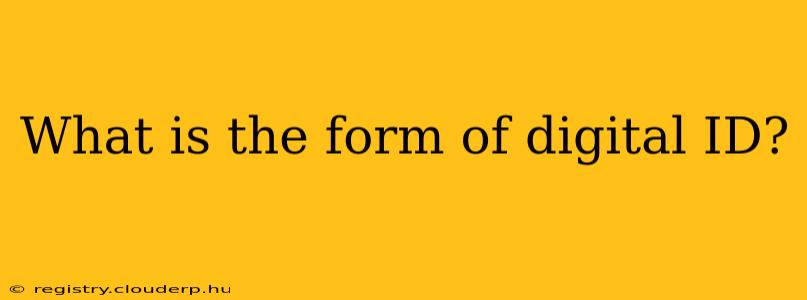The term "digital ID" might conjure images of futuristic holograms, but the reality is far more diverse and practical. A digital identity isn't a single, monolithic thing; rather, it's a collection of data points and technologies used to verify someone's identity online. This post will explore the various forms a digital ID can take, addressing common questions and misconceptions along the way.
What are the different types of digital IDs?
Digital IDs come in many shapes and sizes, each with its own strengths and weaknesses. We can broadly categorize them as follows:
-
Software-based IDs: These are digital credentials stored on your device, often within a dedicated app or wallet. They might utilize technologies like blockchain (for increased security and decentralization), biometrics (fingerprint, facial recognition), or simple password-based authentication. Examples include mobile driver's licenses, digital banking credentials, and some forms of company-issued digital IDs.
-
Hardware-based IDs: These involve physical devices that contain digital identity information. Think smart cards (like those used for secure access to corporate networks) or specialized hardware tokens that generate one-time passwords. These offer heightened security due to their physical protection.
-
Decentralized IDs: This emerging category leverages blockchain technology to store and manage identity information in a distributed, secure manner. Unlike centralized systems controlled by a single entity, decentralized IDs give users more control over their data and privacy. This is still a developing area, but holds significant promise for the future of digital identity.
-
Federated IDs: These rely on a network of trusted entities to verify identities. For example, you might use your existing Google or Facebook account to log into a new website. While convenient, it's crucial to understand the implications for data sharing and privacy when relying on federated IDs.
What information is included in a digital ID?
The specific information included in a digital ID varies widely depending on its purpose and the issuing authority. However, common components include:
- Personal Information: Name, date of birth, address, photo.
- Identifying Numbers: Social Security Number (or equivalent), driver's license number, passport number.
- Biometric Data: Fingerprints, facial scans, iris scans (depending on the level of security).
- Proof of Identity: Documentation such as a scanned copy of a driver's license or passport.
- Credentials: Digital signatures, certificates, and other data demonstrating authority or access.
How secure are digital IDs?
The security of a digital ID depends heavily on its design and implementation. Well-designed systems employ robust encryption, multi-factor authentication, and regular security audits to minimize risks. However, no system is foolproof. Threats include phishing attacks, malware, and potential vulnerabilities in the underlying software or hardware.
What are the benefits of using a digital ID?
Digital IDs offer several advantages over traditional physical IDs:
- Convenience: Easy access and use across multiple online platforms.
- Improved Security: Potentially higher security than physical documents, particularly with robust authentication methods.
- Efficiency: Streamlined processes for identity verification in various contexts.
- Cost Savings: Reduced costs associated with printing, storing, and managing physical documents.
How do digital IDs work with blockchain technology?
Blockchain-based digital IDs leverage the security and transparency of blockchain to securely store and manage identity information. This decentralized approach empowers individuals with greater control over their data while enhancing verification processes through cryptographic methods.
Are digital IDs safe?
The safety of a digital ID hinges upon the security protocols implemented. Strong encryption, multi-factor authentication, and regular security updates are vital components in ensuring the protection of personal data. However, it's always wise to exercise caution and only use trusted digital ID providers.
This exploration provides a comprehensive overview of digital IDs, addressing various forms, security considerations, and benefits. As technology continues to evolve, the landscape of digital identity will undoubtedly become even more nuanced and sophisticated.

